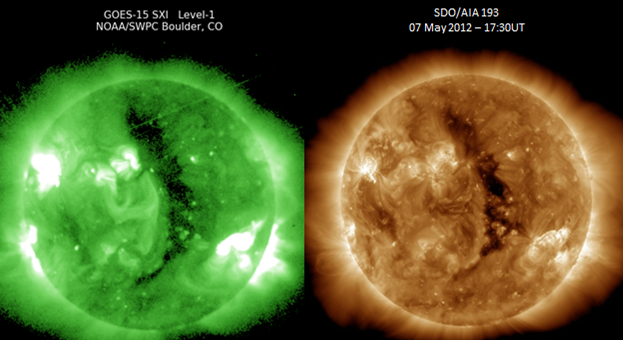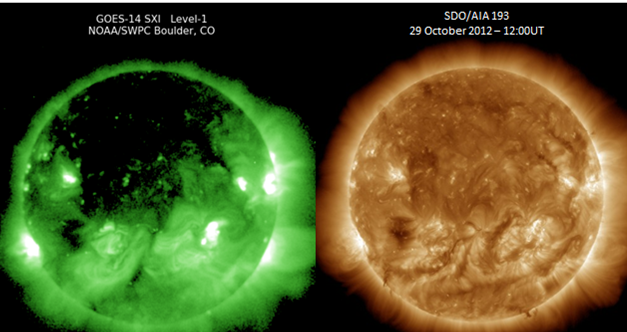Coronal holes are regions in the hot solar atmosphere ("corona") where the plasma density of that temperature is very low compared to its surroundings, and thus they look like dark shapes in the corona. They are also known to be the source of the high-speed solar wind, and as such can create geomagnetic disturbances when aimed at the Earth. As the larger coronal holes may hold their shape through several solar rotations, they are interesting for long term space weather predictions.

In general, both EUV (e.g. SDO ) and soft x-ray (SXR, e.g. GOES/SXI) images correspond very well in showing the coronal holes, though -of course- scientists have to keep an eye on some features that may be seen in SXR and not in EUV (or vice versa). However, images from late October were a bit more difficult to explain, as almost half a solar hemisphere was dark in SXR, while in EUV there was nothing peculiar to report. Where had the coronal hole gone?

As it turns out, there was no coronal hole at all. An STCE scientist explains: "Coronal holes are best seen in the relatively cool wavelengths of the spectrum such as e.g. 19.3 nm (EUV: SDO/AIA 193), corresponding to a temperature of about 1.2 million degrees. If an area looks dark in such images, it means there is not enough material present at that temperature to be visible. That is exactly what happens in coronal holes: The fast solar wind drains the area very quickly of the coronal plasma that otherwise would have been there. As a result, we see a dark area. The normal, quiet corona as well as active regions will not be seen as dark patches in such images.
In SXR-images, the situation is quite different. Such images mainly show plasma at very high temperatures (several millions of degrees). This basically means that in such images, only the active regions (hot) will be visible. Consequently, a black area in SXR-images can mean a coronal hole or the quiet Sun. What we are seeing in this case, and taking into account the EUV-images, is a part of the Sun on which there are significantly less active regions than on the rest of the solar surface."
Actually, the dark area visible in the GOES SXI-images late October and early November corresponds to the inactive "face" of the Sun that was discussed in a previous STCE Newsletter. Last week, this area made another solar transit, though this time it did not show up as pronounced in the SXI-images as it did a solar rotation ago.
 |
 |





